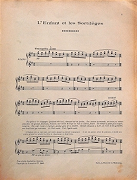
Home > Sheet Music > How to Read Piano Music
|
||||
How to Read Piano Music
Learning where the keys are located on the piano is the first step in understanding how to read piano music. Look through your beginner piano notebooks or online to discover their proper locations. Once you are aware of the composition of your keyboard, you are able to begin the process of learning to play piano. Patience and hard work will be necessary in order to successfully read and interpret various pieces of piano music. There are 7 notes which make up the musical alphabet. Each note is given a letter representative: A, B, C, D, E, F and G. This series of notes repeat themselves from one end of the keyboard to the next. Unfortunately, knowledge of letter names will not help you to read music. Music is translated into notes that are separated into a staff to easily communicate to pianists a series of notes. To properly understand the directions, you must first understand the differences between the two clefs. These signs will indicate whether the notes played are high or low notes, called the treble clef and bass clef. The treble bass consist of low notes, while the bass clef consists of high notes. A general rule dictates that you play the treble clef notes with your right hand, while using your left hand to play the bass clef.
The letters on the lines, starting once again from the bottom, are E, G, B, D, and F. Many people remember this sequence while utilizing: “Every Good Boy Deserves Fudge.” The first letter of every word represents the next note in the sequence, making the memorization process slightly easier. Note placement in the bass clef is slightly different. From the bottom to the top, the notes between the spaces are A, C, E, and G. A useful phrase to remember the sequence is “All Cows Eat Grass.” Notes on the lines of the bass clef are G, B, D, F, A. Easily recalled with the phrase “Great Big Ducks Fly Away.” These are the basic on how to read piano sheet music. You will be able to play a variety of beginner sheet music by utilizing this knowledge. There are a variety of different kinds of notes (whole notes, half notes, 8th notes) which are demonstrated by differences in symbols. Illustrated below are common notes found: By combining the type and length of each note, you will be successful in playing a variety of different piano music.
=> http://pianoplayerworld.com/GospelKeys200.html
| ||||
|
Although every attempt has been made to make information as accurate as possible, we are not responsible for any errors that may appear.
 In order to successfully play piano, you will have to
In order to successfully play piano, you will have to 
 Notes are separated with 5 lines. The position of each note corresponds with
their letter value, depending on whether or not you are using a treble or bass clef. The notes found in the
spaces of the treble clef, starting from the bottom, are F, A, C, and E. These notes are easy to remember as
they spell FACE.
Notes are separated with 5 lines. The position of each note corresponds with
their letter value, depending on whether or not you are using a treble or bass clef. The notes found in the
spaces of the treble clef, starting from the bottom, are F, A, C, and E. These notes are easy to remember as
they spell FACE.



